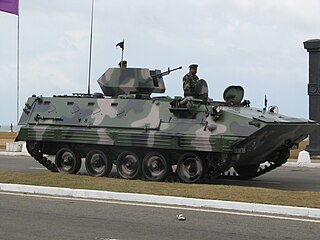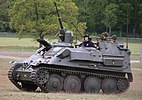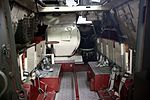
An infantry fighting vehicle (IFV), also known as a mechanized infantry combat vehicle (MICV), is a type of armoured fighting vehicle used to carry infantry into battle and provide direct-fire support. The 1990 Treaty on Conventional Armed Forces in Europe defines an infantry fighting vehicle as "an armoured combat vehicle which is designed and equipped primarily to transport a combat infantry squad, and which is armed with an integral or organic cannon of at least 20 millimeters calibre and sometimes an antitank missile launcher". IFVs often serve both as the principal weapons system and as the mode of transport for a mechanized infantry unit.

Mechanized infantry are infantry units equipped with armored personnel carriers (APCs) or infantry fighting vehicles (IFVs) for transport and combat.

Self-propelled artillery is artillery equipped with its own propulsion system to move toward its firing position. Within the terminology are the self-propelled gun, self-propelled howitzer, self-propelled mortar, and self-propelled rocket artillery. They are high-mobility vehicles, usually based on continuous tracks carrying either a large field gun, howitzer, mortar, or some form of rocket/missile launcher. They are usually used for long-range indirect bombardment support on the battlefield.

The Bradley Fighting Vehicle (BFV) is a tracked armored fighting vehicle of the United States developed by FMC Corporation and now manufactured by BAE Systems Land & Armaments, formerly United Defense. It is named for U.S. General Omar Bradley.

The Panzerkampfwagen 38(t), originally known as the ČKD LT vz. 38, was a tank designed during the 1930s, which saw extensive service during World War II. Developed in Czechoslovakia by ČKD, the type was adopted by Nazi Germany following the annexation of Czechoslovakia. With the German Army and other Axis forces, the type saw service in the invasions of Poland, France and the USSR. Production ended in 1942, when its main armament was deemed inadequate. In all, over 1,400 Pz. 38(t)s were manufactured. The chassis of the Pz. 38(t) continued to be produced for the Marder III (1942–1944) with some of its components used in the later Jagdpanzer 38 (1944–1945) tank destroyer and its derivative vehicles.

The Sd.Kfz. 251 half-track was a World War II German armored personnel carrier designed by the Hanomag company, based on its earlier, unarmored Sd.Kfz. 11 vehicle. The Sd.Kfz. 251 was designed to transport the Panzergrenadier into battle. Sd.Kfz. 251s were the most widely produced German half-tracks of the war, with at least 15,252 vehicles and variants produced by seven manufacturers. The utility of this vehicle led the German Army to develop the similar looking but shorter and lighter Sd.Kfz. 250 as a supplement.

Panzergrenadier, abbreviated as PzG (WWII) or PzGren (modern), meaning "Armour"-ed fighting vehicle "Grenadier", is the German term for the military doctrine of mechanized infantry units in armoured forces who specialize in fighting from and in conjunction with infantry fighting vehicles (IFVs) – that is, armoured troop carriers designed to carry a mechanized squad of six to eight soldiers into, during and out of combat while providing direct fire support for those troops.

The infanterikanonvagn 91, lit. 'infantry cannon wagon 91', was a high mobility assault gun that was developed to meet the operational requirements of the Swedish Army. It was designed and manufactured by Hägglund & Söner and employed common components with the Pbv 302 armoured personnel carrier series. The first prototypes of the ikv 91 were completed in 1969 with production running from 1975 until 1978. In total, 212 were manufactured.

Pansarbandvagn 302, meaning roughly armoured tracked carrier vehicle 302, is a Swedish high-mobility infantry fighting vehicle used by the Swedish Army from 1966 to 2014.

Stridsvagn 74 was a Swedish light tank in use with the Swedish Army from 1958 to 1984. It was a modification of the older stridsvagn m/42 medium tank, which was phased out of service in the early 1950s. Instead of scrapping the vehicles altogether, the chassis were used to build a new tank which could be used as a supplement to the newly bought stridsvagn 81. The turret of the strv 74 was completely new, with a 75 mm high-velocity gun based on an older anti-aircraft gun Bofors 75 mm Model 1929, engines and transmission were modified or changed from the strv m/42, wider tracks and a separate electrical motor for turret traverse was introduced while retaining manual traverse as a backup.

Stridsvagn m/41 was a Swedish medium tank. A license-built version of the Czechoslovak TNH medium tank, it served into the 1950s.

The ZBD-04 or Type 04 is a Chinese infantry fighting vehicle. It bears some external resemblance to the BMP-3, particularly with regards to its turret and main armament; However, the chassis and internal subsystem possesses a different layout. The earliest prototypes received the designation ZBD-97. An improved version, ZBD-04A, is the vehicle currently in service and being produced.

The Norinco Type 89 tracked armoured fighting vehicle is a Chinese armoured personnel carrier. It was developed from the earlier export market Type 85 AFV vehicle. It entered service in the late 1990s and was first shown publicly in 1999. There are approximately 1,000 in service. It has the industrial index of WZ534 and although it was mainly developed for the PLA, there is also an export version YW534.

Stridsvagn m/37 was a Swedish-built version of the Czechoslovak ČKD AH-IV tankette.

The Södermanland Regiment, designated P 10 or P 3 and P 10/Fo 43, was an armored regiment of the Swedish Army with its roots in the 17th century, and was located in Strängnäs. The regiment was deactivated in 2004 and its assets were funneled into other parts of the military. Its life company was transferred to the Södermanland Group of the Home Guard, making the Södermanland Group the only Home Guard unit with such a company.

Terrängbil m/42 KP, meaning "terrain car m/42 KP", colloquially known as "KP-car", was an early Swedish infantry fighting vehicle developed during World War II. At its core is a flatbed truck with 4 wheel drive for off-road driving, fitted with an armoured body elongated over and around the bed, with a troop transport compartment behind the cabin for a panzergrenadier squad of 16.

This article deals with the history and development of tanks employed by the military of Sweden, from the interwar period, and World War II, the Cold War and modern era.
The Lyran illuminating mortar is a 71mm mortar designed by Bofors Weapon Systems primarily for armoured vehicles to fire flares to illuminate battlefields and targets. It can also be used as an infantry weapon and in marine applications.





















